Financial Management for Businesses
VerifiedAdded on 2020/01/15
|12
|4021
|149
AI Summary
This assignment delves into the core concepts of financial management for businesses. It examines different budgeting methodologies such as zero-base budgeting, activity-based budgeting, and rolling budgets, outlining their applications and advantages. Additionally, it explores various costing techniques employed in financial analysis and decision-making. Students are expected to demonstrate a comprehensive understanding of these financial management principles and their practical implications in business settings.
Contribute Materials
Your contribution can guide someone’s learning journey. Share your
documents today.
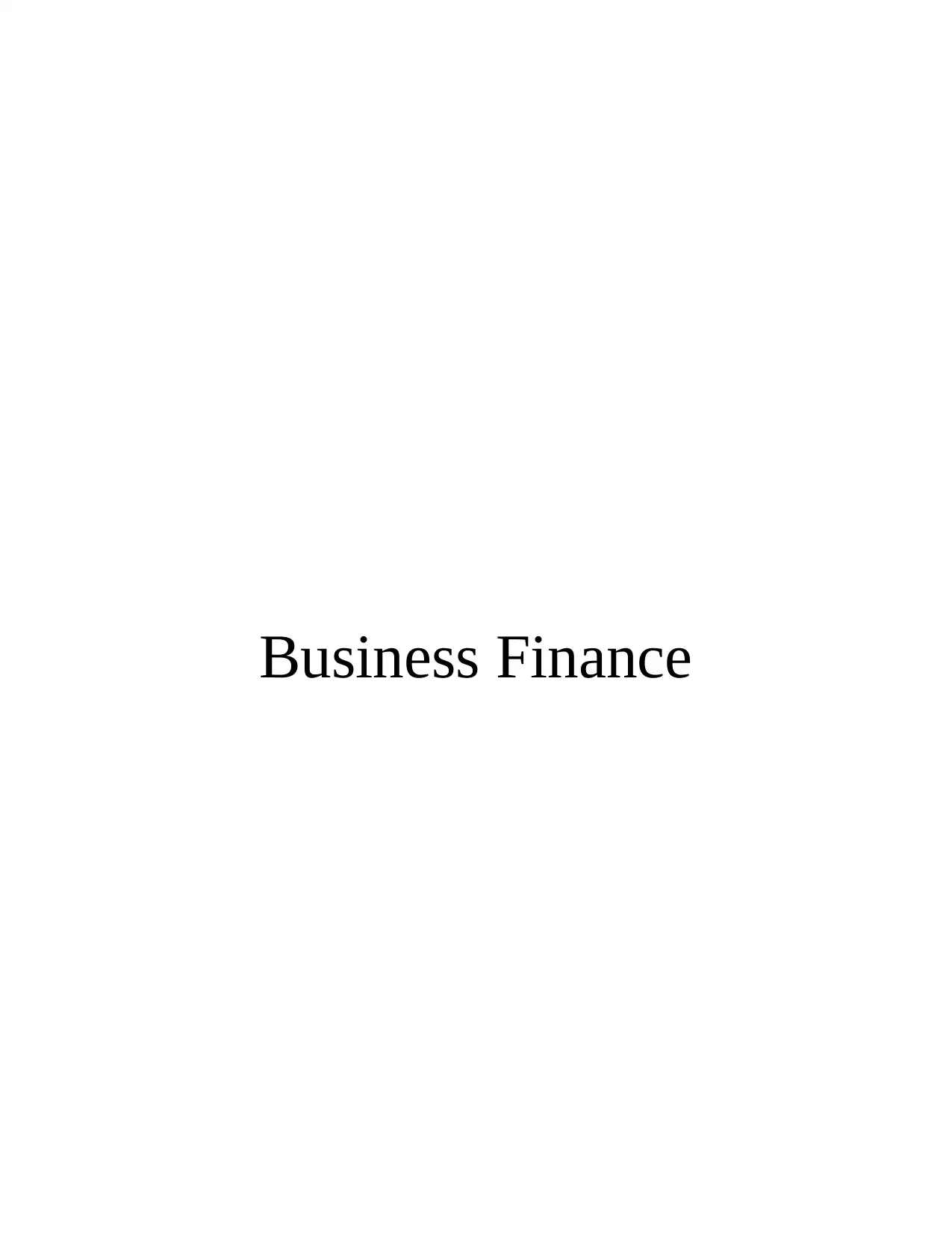
Business Finance
Secure Best Marks with AI Grader
Need help grading? Try our AI Grader for instant feedback on your assignments.
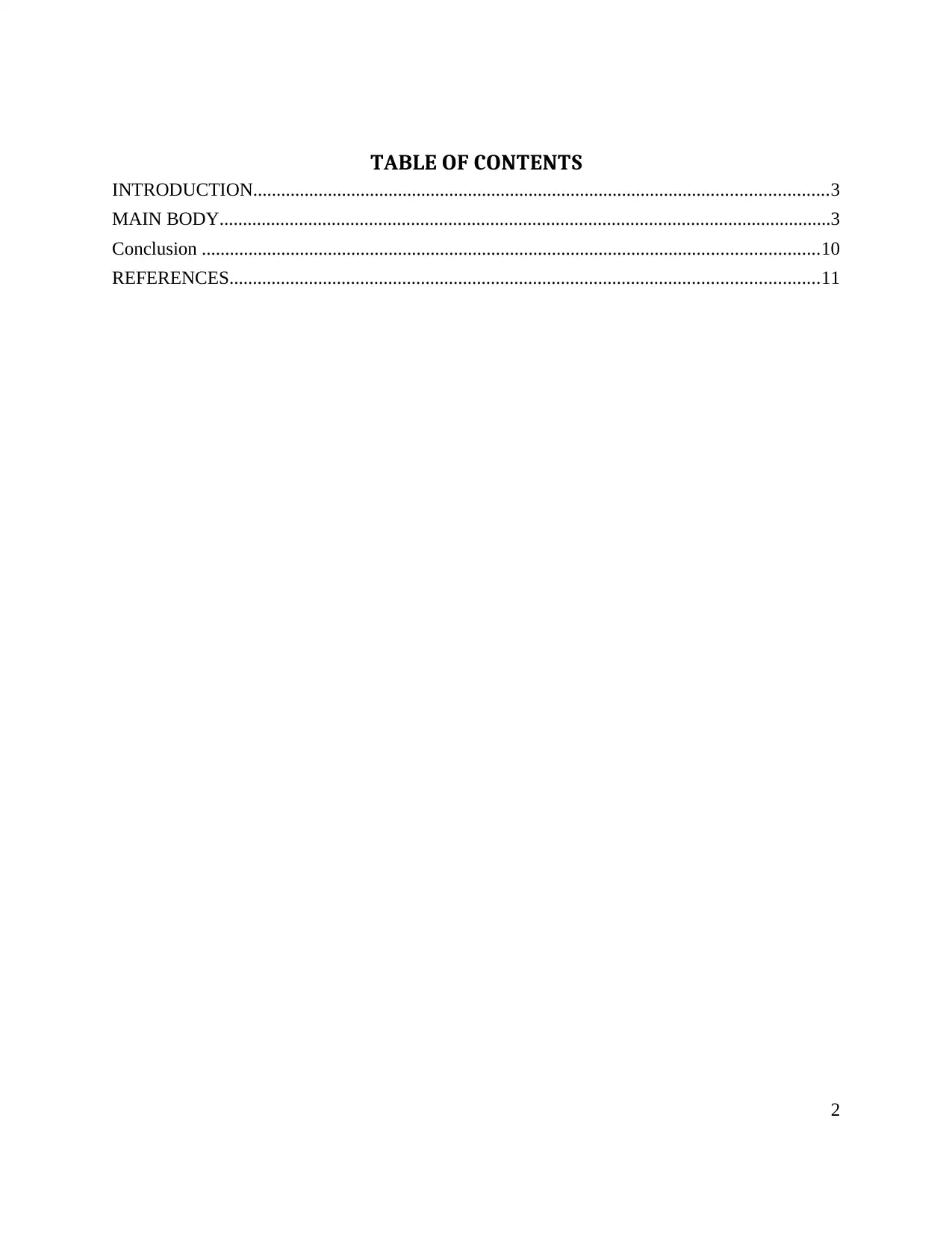
TABLE OF CONTENTS
INTRODUCTION...........................................................................................................................3
MAIN BODY...................................................................................................................................3
Conclusion ....................................................................................................................................10
REFERENCES..............................................................................................................................11
2
INTRODUCTION...........................................................................................................................3
MAIN BODY...................................................................................................................................3
Conclusion ....................................................................................................................................10
REFERENCES..............................................................................................................................11
2
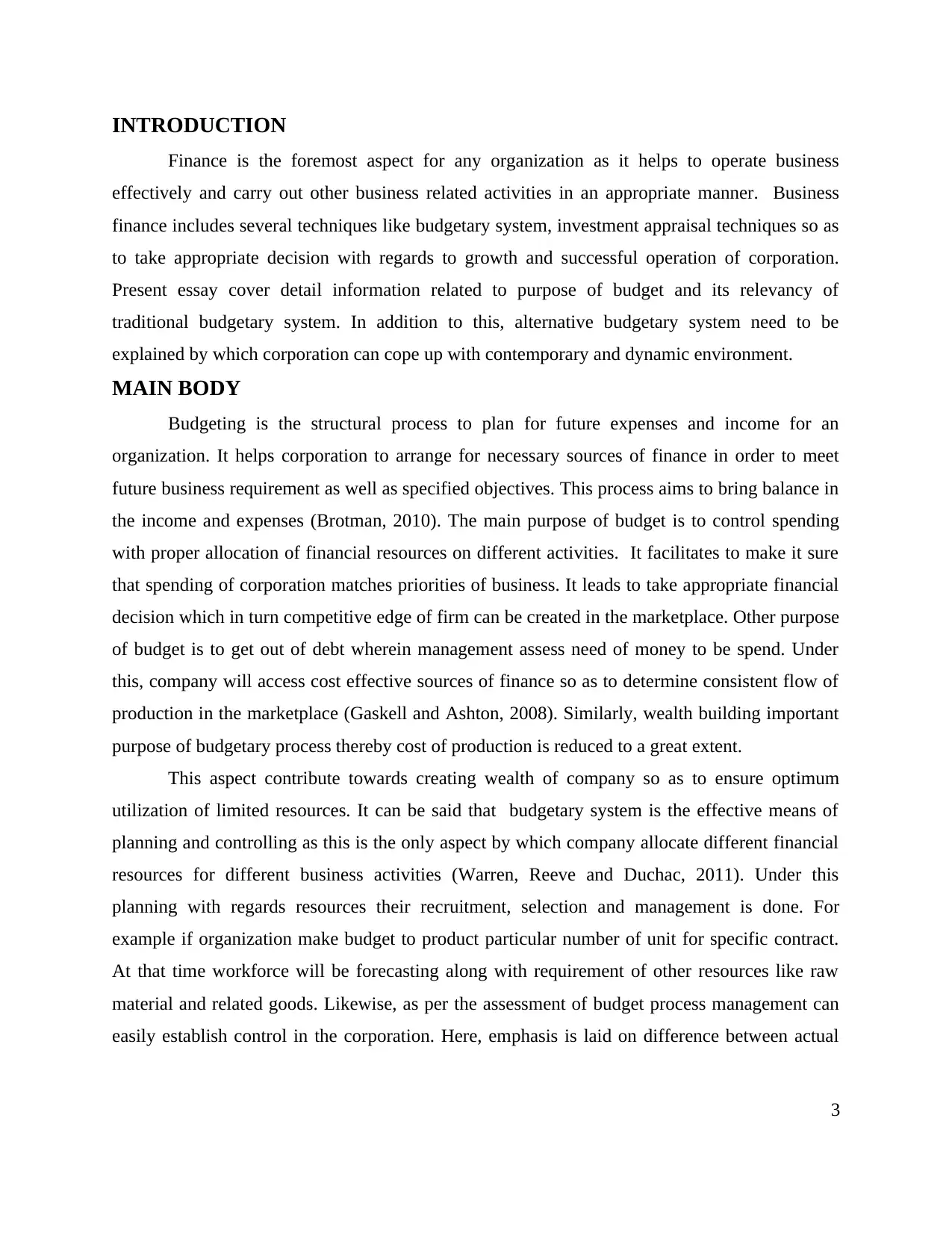
INTRODUCTION
Finance is the foremost aspect for any organization as it helps to operate business
effectively and carry out other business related activities in an appropriate manner. Business
finance includes several techniques like budgetary system, investment appraisal techniques so as
to take appropriate decision with regards to growth and successful operation of corporation.
Present essay cover detail information related to purpose of budget and its relevancy of
traditional budgetary system. In addition to this, alternative budgetary system need to be
explained by which corporation can cope up with contemporary and dynamic environment.
MAIN BODY
Budgeting is the structural process to plan for future expenses and income for an
organization. It helps corporation to arrange for necessary sources of finance in order to meet
future business requirement as well as specified objectives. This process aims to bring balance in
the income and expenses (Brotman, 2010). The main purpose of budget is to control spending
with proper allocation of financial resources on different activities. It facilitates to make it sure
that spending of corporation matches priorities of business. It leads to take appropriate financial
decision which in turn competitive edge of firm can be created in the marketplace. Other purpose
of budget is to get out of debt wherein management assess need of money to be spend. Under
this, company will access cost effective sources of finance so as to determine consistent flow of
production in the marketplace (Gaskell and Ashton, 2008). Similarly, wealth building important
purpose of budgetary process thereby cost of production is reduced to a great extent.
This aspect contribute towards creating wealth of company so as to ensure optimum
utilization of limited resources. It can be said that budgetary system is the effective means of
planning and controlling as this is the only aspect by which company allocate different financial
resources for different business activities (Warren, Reeve and Duchac, 2011). Under this
planning with regards resources their recruitment, selection and management is done. For
example if organization make budget to product particular number of unit for specific contract.
At that time workforce will be forecasting along with requirement of other resources like raw
material and related goods. Likewise, as per the assessment of budget process management can
easily establish control in the corporation. Here, emphasis is laid on difference between actual
3
Finance is the foremost aspect for any organization as it helps to operate business
effectively and carry out other business related activities in an appropriate manner. Business
finance includes several techniques like budgetary system, investment appraisal techniques so as
to take appropriate decision with regards to growth and successful operation of corporation.
Present essay cover detail information related to purpose of budget and its relevancy of
traditional budgetary system. In addition to this, alternative budgetary system need to be
explained by which corporation can cope up with contemporary and dynamic environment.
MAIN BODY
Budgeting is the structural process to plan for future expenses and income for an
organization. It helps corporation to arrange for necessary sources of finance in order to meet
future business requirement as well as specified objectives. This process aims to bring balance in
the income and expenses (Brotman, 2010). The main purpose of budget is to control spending
with proper allocation of financial resources on different activities. It facilitates to make it sure
that spending of corporation matches priorities of business. It leads to take appropriate financial
decision which in turn competitive edge of firm can be created in the marketplace. Other purpose
of budget is to get out of debt wherein management assess need of money to be spend. Under
this, company will access cost effective sources of finance so as to determine consistent flow of
production in the marketplace (Gaskell and Ashton, 2008). Similarly, wealth building important
purpose of budgetary process thereby cost of production is reduced to a great extent.
This aspect contribute towards creating wealth of company so as to ensure optimum
utilization of limited resources. It can be said that budgetary system is the effective means of
planning and controlling as this is the only aspect by which company allocate different financial
resources for different business activities (Warren, Reeve and Duchac, 2011). Under this
planning with regards resources their recruitment, selection and management is done. For
example if organization make budget to product particular number of unit for specific contract.
At that time workforce will be forecasting along with requirement of other resources like raw
material and related goods. Likewise, as per the assessment of budget process management can
easily establish control in the corporation. Here, emphasis is laid on difference between actual
3
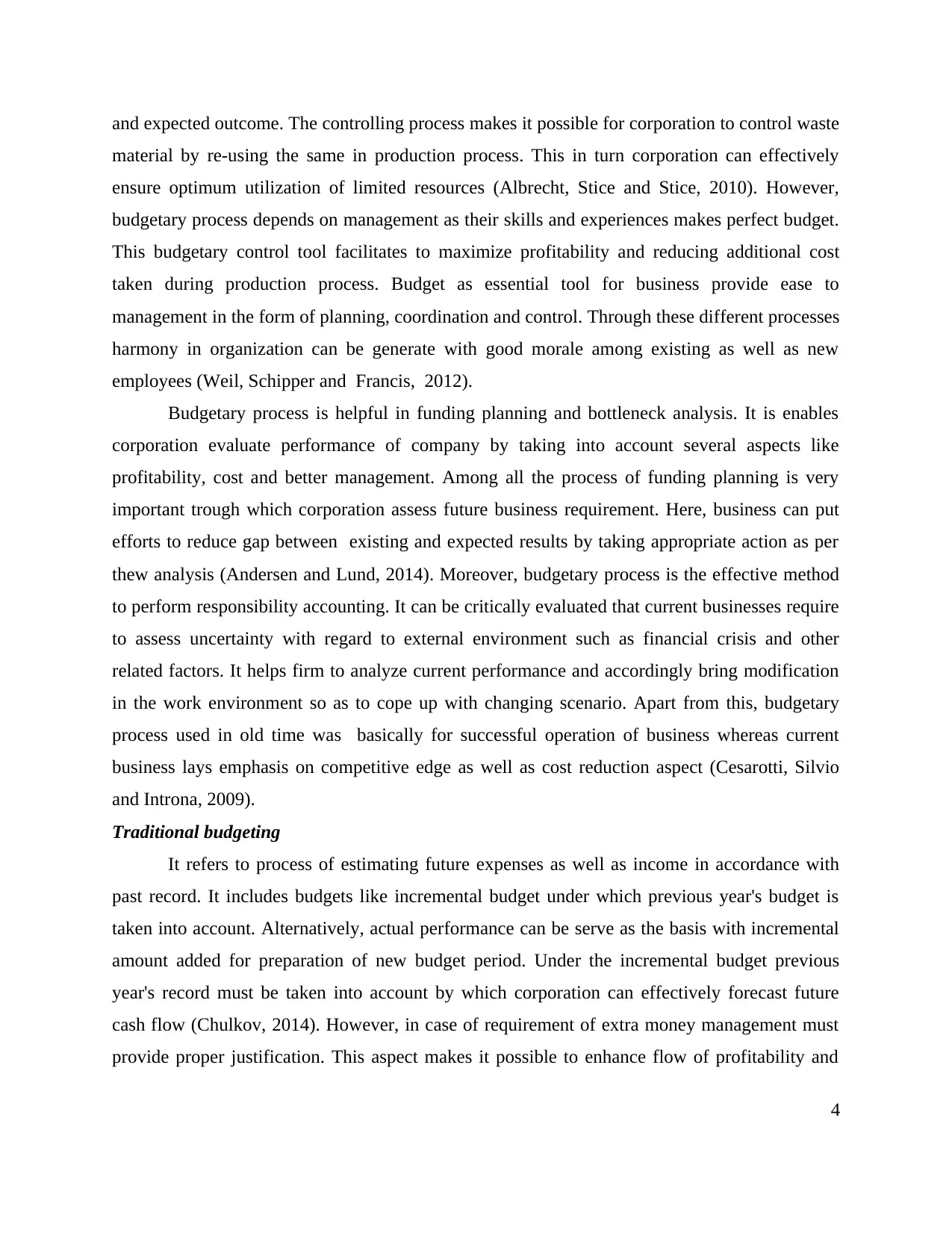
and expected outcome. The controlling process makes it possible for corporation to control waste
material by re-using the same in production process. This in turn corporation can effectively
ensure optimum utilization of limited resources (Albrecht, Stice and Stice, 2010). However,
budgetary process depends on management as their skills and experiences makes perfect budget.
This budgetary control tool facilitates to maximize profitability and reducing additional cost
taken during production process. Budget as essential tool for business provide ease to
management in the form of planning, coordination and control. Through these different processes
harmony in organization can be generate with good morale among existing as well as new
employees (Weil, Schipper and Francis, 2012).
Budgetary process is helpful in funding planning and bottleneck analysis. It is enables
corporation evaluate performance of company by taking into account several aspects like
profitability, cost and better management. Among all the process of funding planning is very
important trough which corporation assess future business requirement. Here, business can put
efforts to reduce gap between existing and expected results by taking appropriate action as per
thew analysis (Andersen and Lund, 2014). Moreover, budgetary process is the effective method
to perform responsibility accounting. It can be critically evaluated that current businesses require
to assess uncertainty with regard to external environment such as financial crisis and other
related factors. It helps firm to analyze current performance and accordingly bring modification
in the work environment so as to cope up with changing scenario. Apart from this, budgetary
process used in old time was basically for successful operation of business whereas current
business lays emphasis on competitive edge as well as cost reduction aspect (Cesarotti, Silvio
and Introna, 2009).
Traditional budgeting
It refers to process of estimating future expenses as well as income in accordance with
past record. It includes budgets like incremental budget under which previous year's budget is
taken into account. Alternatively, actual performance can be serve as the basis with incremental
amount added for preparation of new budget period. Under the incremental budget previous
year's record must be taken into account by which corporation can effectively forecast future
cash flow (Chulkov, 2014). However, in case of requirement of extra money management must
provide proper justification. This aspect makes it possible to enhance flow of profitability and
4
material by re-using the same in production process. This in turn corporation can effectively
ensure optimum utilization of limited resources (Albrecht, Stice and Stice, 2010). However,
budgetary process depends on management as their skills and experiences makes perfect budget.
This budgetary control tool facilitates to maximize profitability and reducing additional cost
taken during production process. Budget as essential tool for business provide ease to
management in the form of planning, coordination and control. Through these different processes
harmony in organization can be generate with good morale among existing as well as new
employees (Weil, Schipper and Francis, 2012).
Budgetary process is helpful in funding planning and bottleneck analysis. It is enables
corporation evaluate performance of company by taking into account several aspects like
profitability, cost and better management. Among all the process of funding planning is very
important trough which corporation assess future business requirement. Here, business can put
efforts to reduce gap between existing and expected results by taking appropriate action as per
thew analysis (Andersen and Lund, 2014). Moreover, budgetary process is the effective method
to perform responsibility accounting. It can be critically evaluated that current businesses require
to assess uncertainty with regard to external environment such as financial crisis and other
related factors. It helps firm to analyze current performance and accordingly bring modification
in the work environment so as to cope up with changing scenario. Apart from this, budgetary
process used in old time was basically for successful operation of business whereas current
business lays emphasis on competitive edge as well as cost reduction aspect (Cesarotti, Silvio
and Introna, 2009).
Traditional budgeting
It refers to process of estimating future expenses as well as income in accordance with
past record. It includes budgets like incremental budget under which previous year's budget is
taken into account. Alternatively, actual performance can be serve as the basis with incremental
amount added for preparation of new budget period. Under the incremental budget previous
year's record must be taken into account by which corporation can effectively forecast future
cash flow (Chulkov, 2014). However, in case of requirement of extra money management must
provide proper justification. This aspect makes it possible to enhance flow of profitability and
4
Secure Best Marks with AI Grader
Need help grading? Try our AI Grader for instant feedback on your assignments.
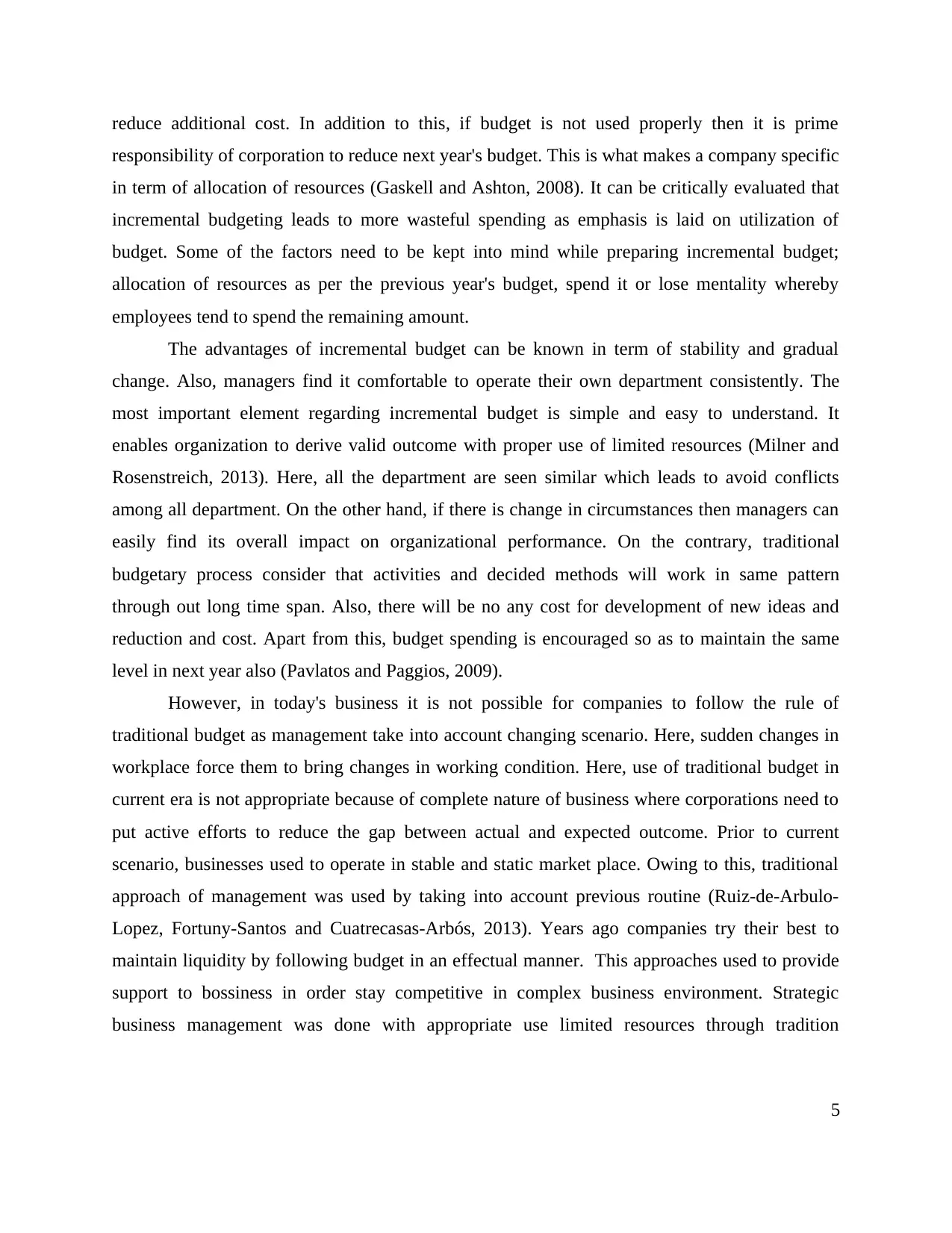
reduce additional cost. In addition to this, if budget is not used properly then it is prime
responsibility of corporation to reduce next year's budget. This is what makes a company specific
in term of allocation of resources (Gaskell and Ashton, 2008). It can be critically evaluated that
incremental budgeting leads to more wasteful spending as emphasis is laid on utilization of
budget. Some of the factors need to be kept into mind while preparing incremental budget;
allocation of resources as per the previous year's budget, spend it or lose mentality whereby
employees tend to spend the remaining amount.
The advantages of incremental budget can be known in term of stability and gradual
change. Also, managers find it comfortable to operate their own department consistently. The
most important element regarding incremental budget is simple and easy to understand. It
enables organization to derive valid outcome with proper use of limited resources (Milner and
Rosenstreich, 2013). Here, all the department are seen similar which leads to avoid conflicts
among all department. On the other hand, if there is change in circumstances then managers can
easily find its overall impact on organizational performance. On the contrary, traditional
budgetary process consider that activities and decided methods will work in same pattern
through out long time span. Also, there will be no any cost for development of new ideas and
reduction and cost. Apart from this, budget spending is encouraged so as to maintain the same
level in next year also (Pavlatos and Paggios, 2009).
However, in today's business it is not possible for companies to follow the rule of
traditional budget as management take into account changing scenario. Here, sudden changes in
workplace force them to bring changes in working condition. Here, use of traditional budget in
current era is not appropriate because of complete nature of business where corporations need to
put active efforts to reduce the gap between actual and expected outcome. Prior to current
scenario, businesses used to operate in stable and static market place. Owing to this, traditional
approach of management was used by taking into account previous routine (Ruiz-de-Arbulo-
Lopez, Fortuny-Santos and Cuatrecasas-Arbós, 2013). Years ago companies try their best to
maintain liquidity by following budget in an effectual manner. This approaches used to provide
support to bossiness in order stay competitive in complex business environment. Strategic
business management was done with appropriate use limited resources through tradition
5
responsibility of corporation to reduce next year's budget. This is what makes a company specific
in term of allocation of resources (Gaskell and Ashton, 2008). It can be critically evaluated that
incremental budgeting leads to more wasteful spending as emphasis is laid on utilization of
budget. Some of the factors need to be kept into mind while preparing incremental budget;
allocation of resources as per the previous year's budget, spend it or lose mentality whereby
employees tend to spend the remaining amount.
The advantages of incremental budget can be known in term of stability and gradual
change. Also, managers find it comfortable to operate their own department consistently. The
most important element regarding incremental budget is simple and easy to understand. It
enables organization to derive valid outcome with proper use of limited resources (Milner and
Rosenstreich, 2013). Here, all the department are seen similar which leads to avoid conflicts
among all department. On the other hand, if there is change in circumstances then managers can
easily find its overall impact on organizational performance. On the contrary, traditional
budgetary process consider that activities and decided methods will work in same pattern
through out long time span. Also, there will be no any cost for development of new ideas and
reduction and cost. Apart from this, budget spending is encouraged so as to maintain the same
level in next year also (Pavlatos and Paggios, 2009).
However, in today's business it is not possible for companies to follow the rule of
traditional budget as management take into account changing scenario. Here, sudden changes in
workplace force them to bring changes in working condition. Here, use of traditional budget in
current era is not appropriate because of complete nature of business where corporations need to
put active efforts to reduce the gap between actual and expected outcome. Prior to current
scenario, businesses used to operate in stable and static market place. Owing to this, traditional
approach of management was used by taking into account previous routine (Ruiz-de-Arbulo-
Lopez, Fortuny-Santos and Cuatrecasas-Arbós, 2013). Years ago companies try their best to
maintain liquidity by following budget in an effectual manner. This approaches used to provide
support to bossiness in order stay competitive in complex business environment. Strategic
business management was done with appropriate use limited resources through tradition
5
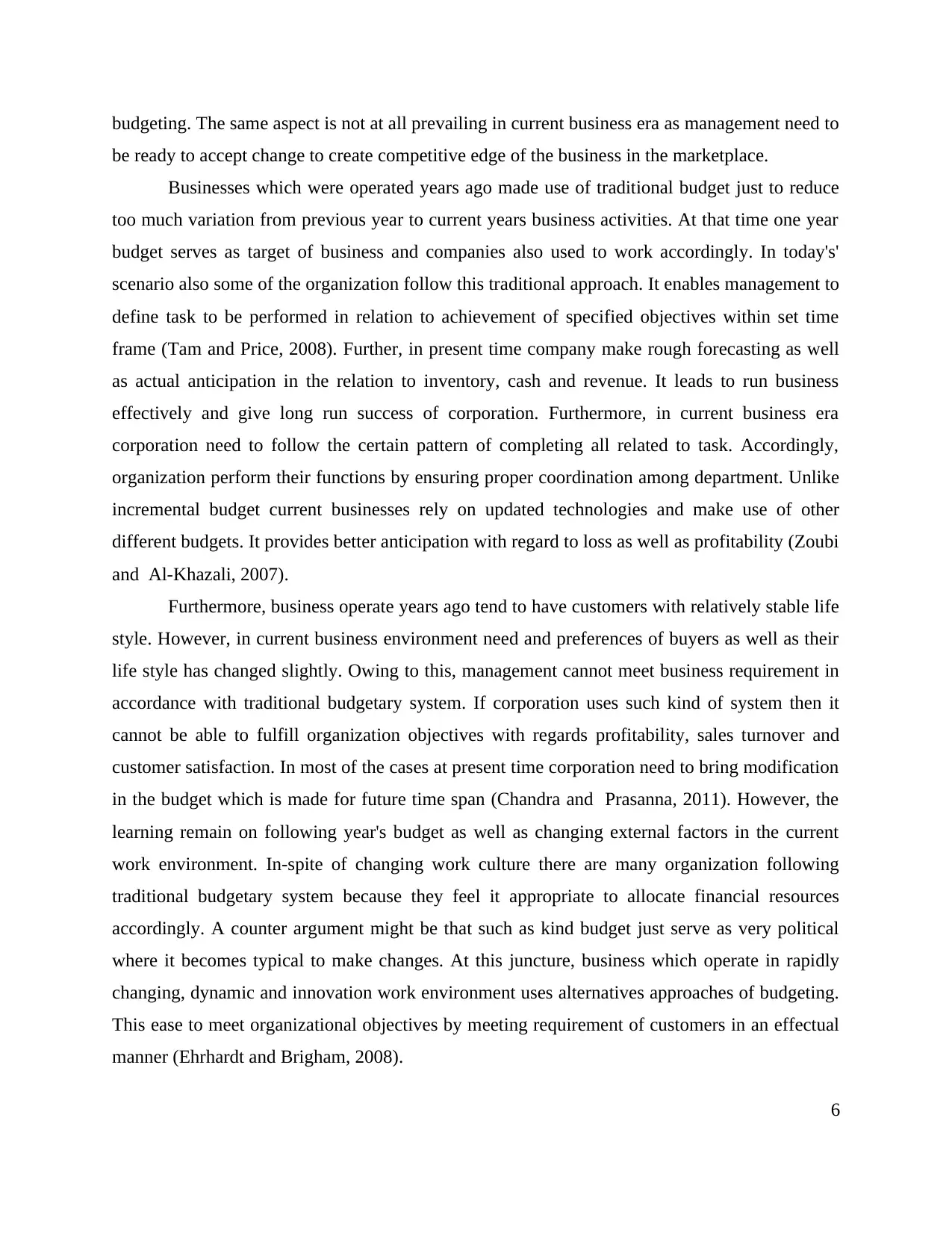
budgeting. The same aspect is not at all prevailing in current business era as management need to
be ready to accept change to create competitive edge of the business in the marketplace.
Businesses which were operated years ago made use of traditional budget just to reduce
too much variation from previous year to current years business activities. At that time one year
budget serves as target of business and companies also used to work accordingly. In today's'
scenario also some of the organization follow this traditional approach. It enables management to
define task to be performed in relation to achievement of specified objectives within set time
frame (Tam and Price, 2008). Further, in present time company make rough forecasting as well
as actual anticipation in the relation to inventory, cash and revenue. It leads to run business
effectively and give long run success of corporation. Furthermore, in current business era
corporation need to follow the certain pattern of completing all related to task. Accordingly,
organization perform their functions by ensuring proper coordination among department. Unlike
incremental budget current businesses rely on updated technologies and make use of other
different budgets. It provides better anticipation with regard to loss as well as profitability (Zoubi
and Al-Khazali, 2007).
Furthermore, business operate years ago tend to have customers with relatively stable life
style. However, in current business environment need and preferences of buyers as well as their
life style has changed slightly. Owing to this, management cannot meet business requirement in
accordance with traditional budgetary system. If corporation uses such kind of system then it
cannot be able to fulfill organization objectives with regards profitability, sales turnover and
customer satisfaction. In most of the cases at present time corporation need to bring modification
in the budget which is made for future time span (Chandra and Prasanna, 2011). However, the
learning remain on following year's budget as well as changing external factors in the current
work environment. In-spite of changing work culture there are many organization following
traditional budgetary system because they feel it appropriate to allocate financial resources
accordingly. A counter argument might be that such as kind budget just serve as very political
where it becomes typical to make changes. At this juncture, business which operate in rapidly
changing, dynamic and innovation work environment uses alternatives approaches of budgeting.
This ease to meet organizational objectives by meeting requirement of customers in an effectual
manner (Ehrhardt and Brigham, 2008).
6
be ready to accept change to create competitive edge of the business in the marketplace.
Businesses which were operated years ago made use of traditional budget just to reduce
too much variation from previous year to current years business activities. At that time one year
budget serves as target of business and companies also used to work accordingly. In today's'
scenario also some of the organization follow this traditional approach. It enables management to
define task to be performed in relation to achievement of specified objectives within set time
frame (Tam and Price, 2008). Further, in present time company make rough forecasting as well
as actual anticipation in the relation to inventory, cash and revenue. It leads to run business
effectively and give long run success of corporation. Furthermore, in current business era
corporation need to follow the certain pattern of completing all related to task. Accordingly,
organization perform their functions by ensuring proper coordination among department. Unlike
incremental budget current businesses rely on updated technologies and make use of other
different budgets. It provides better anticipation with regard to loss as well as profitability (Zoubi
and Al-Khazali, 2007).
Furthermore, business operate years ago tend to have customers with relatively stable life
style. However, in current business environment need and preferences of buyers as well as their
life style has changed slightly. Owing to this, management cannot meet business requirement in
accordance with traditional budgetary system. If corporation uses such kind of system then it
cannot be able to fulfill organization objectives with regards profitability, sales turnover and
customer satisfaction. In most of the cases at present time corporation need to bring modification
in the budget which is made for future time span (Chandra and Prasanna, 2011). However, the
learning remain on following year's budget as well as changing external factors in the current
work environment. In-spite of changing work culture there are many organization following
traditional budgetary system because they feel it appropriate to allocate financial resources
accordingly. A counter argument might be that such as kind budget just serve as very political
where it becomes typical to make changes. At this juncture, business which operate in rapidly
changing, dynamic and innovation work environment uses alternatives approaches of budgeting.
This ease to meet organizational objectives by meeting requirement of customers in an effectual
manner (Ehrhardt and Brigham, 2008).
6
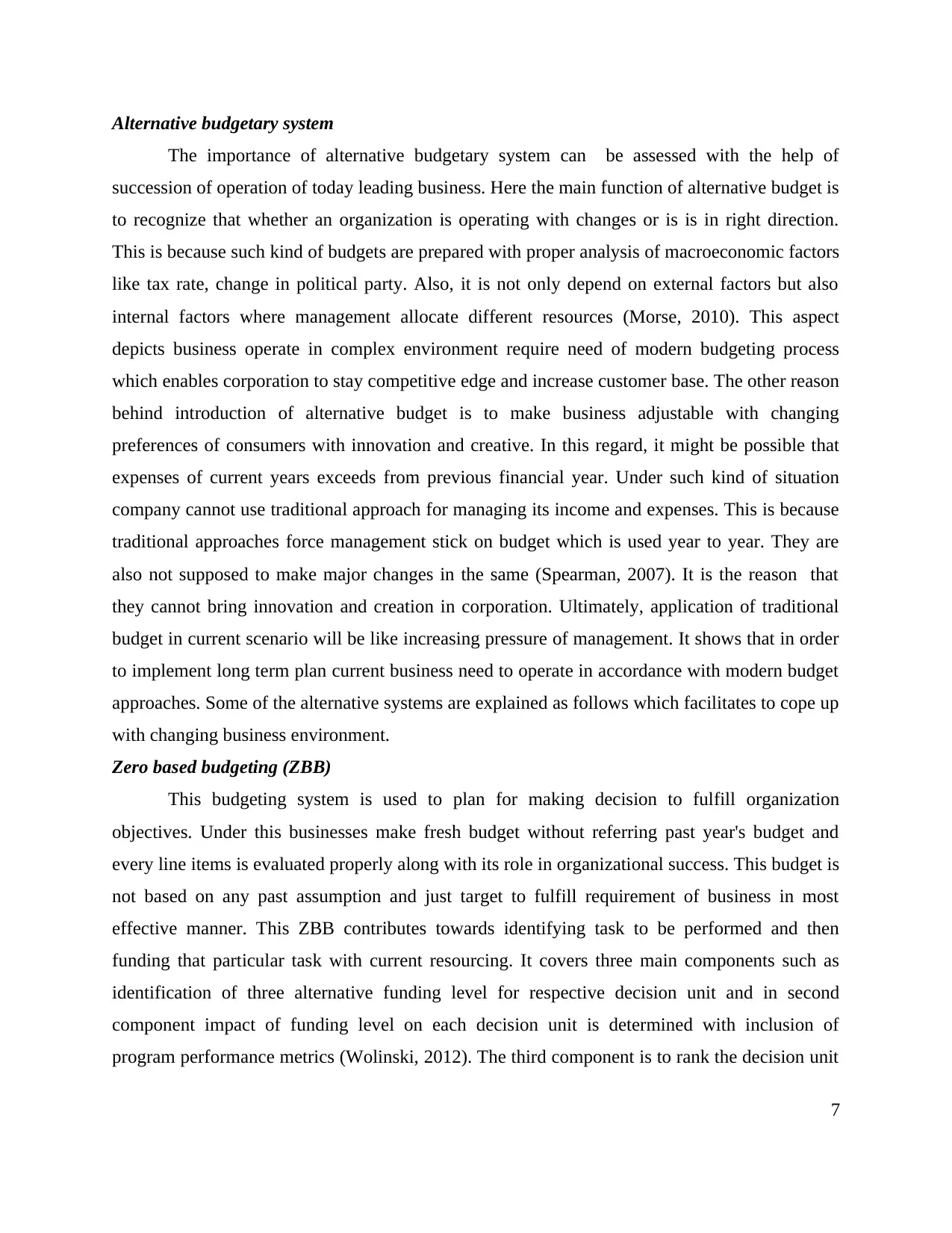
Alternative budgetary system
The importance of alternative budgetary system can be assessed with the help of
succession of operation of today leading business. Here the main function of alternative budget is
to recognize that whether an organization is operating with changes or is is in right direction.
This is because such kind of budgets are prepared with proper analysis of macroeconomic factors
like tax rate, change in political party. Also, it is not only depend on external factors but also
internal factors where management allocate different resources (Morse, 2010). This aspect
depicts business operate in complex environment require need of modern budgeting process
which enables corporation to stay competitive edge and increase customer base. The other reason
behind introduction of alternative budget is to make business adjustable with changing
preferences of consumers with innovation and creative. In this regard, it might be possible that
expenses of current years exceeds from previous financial year. Under such kind of situation
company cannot use traditional approach for managing its income and expenses. This is because
traditional approaches force management stick on budget which is used year to year. They are
also not supposed to make major changes in the same (Spearman, 2007). It is the reason that
they cannot bring innovation and creation in corporation. Ultimately, application of traditional
budget in current scenario will be like increasing pressure of management. It shows that in order
to implement long term plan current business need to operate in accordance with modern budget
approaches. Some of the alternative systems are explained as follows which facilitates to cope up
with changing business environment.
Zero based budgeting (ZBB)
This budgeting system is used to plan for making decision to fulfill organization
objectives. Under this businesses make fresh budget without referring past year's budget and
every line items is evaluated properly along with its role in organizational success. This budget is
not based on any past assumption and just target to fulfill requirement of business in most
effective manner. This ZBB contributes towards identifying task to be performed and then
funding that particular task with current resourcing. It covers three main components such as
identification of three alternative funding level for respective decision unit and in second
component impact of funding level on each decision unit is determined with inclusion of
program performance metrics (Wolinski, 2012). The third component is to rank the decision unit
7
The importance of alternative budgetary system can be assessed with the help of
succession of operation of today leading business. Here the main function of alternative budget is
to recognize that whether an organization is operating with changes or is is in right direction.
This is because such kind of budgets are prepared with proper analysis of macroeconomic factors
like tax rate, change in political party. Also, it is not only depend on external factors but also
internal factors where management allocate different resources (Morse, 2010). This aspect
depicts business operate in complex environment require need of modern budgeting process
which enables corporation to stay competitive edge and increase customer base. The other reason
behind introduction of alternative budget is to make business adjustable with changing
preferences of consumers with innovation and creative. In this regard, it might be possible that
expenses of current years exceeds from previous financial year. Under such kind of situation
company cannot use traditional approach for managing its income and expenses. This is because
traditional approaches force management stick on budget which is used year to year. They are
also not supposed to make major changes in the same (Spearman, 2007). It is the reason that
they cannot bring innovation and creation in corporation. Ultimately, application of traditional
budget in current scenario will be like increasing pressure of management. It shows that in order
to implement long term plan current business need to operate in accordance with modern budget
approaches. Some of the alternative systems are explained as follows which facilitates to cope up
with changing business environment.
Zero based budgeting (ZBB)
This budgeting system is used to plan for making decision to fulfill organization
objectives. Under this businesses make fresh budget without referring past year's budget and
every line items is evaluated properly along with its role in organizational success. This budget is
not based on any past assumption and just target to fulfill requirement of business in most
effective manner. This ZBB contributes towards identifying task to be performed and then
funding that particular task with current resourcing. It covers three main components such as
identification of three alternative funding level for respective decision unit and in second
component impact of funding level on each decision unit is determined with inclusion of
program performance metrics (Wolinski, 2012). The third component is to rank the decision unit
7
Paraphrase This Document
Need a fresh take? Get an instant paraphrase of this document with our AI Paraphraser
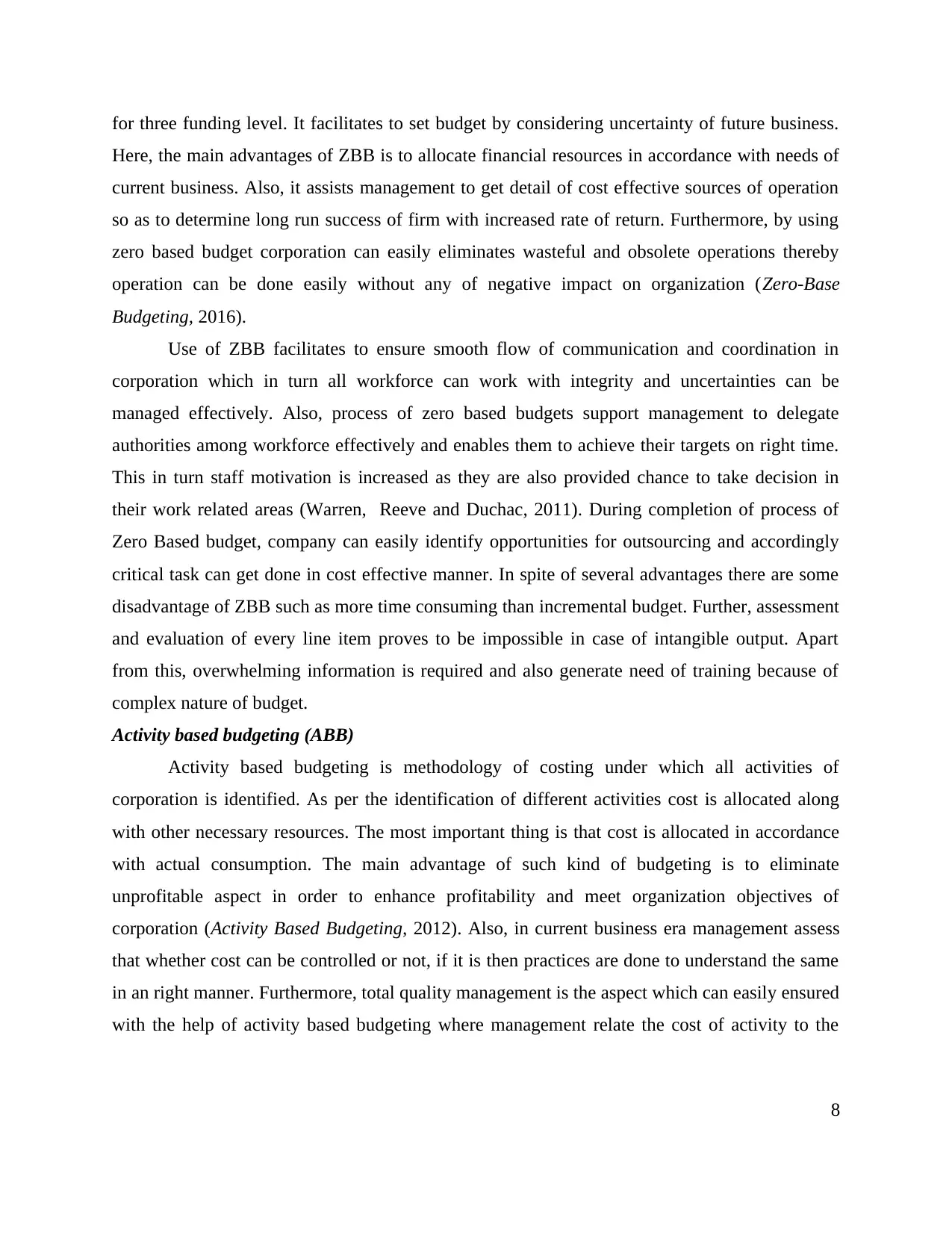
for three funding level. It facilitates to set budget by considering uncertainty of future business.
Here, the main advantages of ZBB is to allocate financial resources in accordance with needs of
current business. Also, it assists management to get detail of cost effective sources of operation
so as to determine long run success of firm with increased rate of return. Furthermore, by using
zero based budget corporation can easily eliminates wasteful and obsolete operations thereby
operation can be done easily without any of negative impact on organization (Zero-Base
Budgeting, 2016).
Use of ZBB facilitates to ensure smooth flow of communication and coordination in
corporation which in turn all workforce can work with integrity and uncertainties can be
managed effectively. Also, process of zero based budgets support management to delegate
authorities among workforce effectively and enables them to achieve their targets on right time.
This in turn staff motivation is increased as they are also provided chance to take decision in
their work related areas (Warren, Reeve and Duchac, 2011). During completion of process of
Zero Based budget, company can easily identify opportunities for outsourcing and accordingly
critical task can get done in cost effective manner. In spite of several advantages there are some
disadvantage of ZBB such as more time consuming than incremental budget. Further, assessment
and evaluation of every line item proves to be impossible in case of intangible output. Apart
from this, overwhelming information is required and also generate need of training because of
complex nature of budget.
Activity based budgeting (ABB)
Activity based budgeting is methodology of costing under which all activities of
corporation is identified. As per the identification of different activities cost is allocated along
with other necessary resources. The most important thing is that cost is allocated in accordance
with actual consumption. The main advantage of such kind of budgeting is to eliminate
unprofitable aspect in order to enhance profitability and meet organization objectives of
corporation (Activity Based Budgeting, 2012). Also, in current business era management assess
that whether cost can be controlled or not, if it is then practices are done to understand the same
in an right manner. Furthermore, total quality management is the aspect which can easily ensured
with the help of activity based budgeting where management relate the cost of activity to the
8
Here, the main advantages of ZBB is to allocate financial resources in accordance with needs of
current business. Also, it assists management to get detail of cost effective sources of operation
so as to determine long run success of firm with increased rate of return. Furthermore, by using
zero based budget corporation can easily eliminates wasteful and obsolete operations thereby
operation can be done easily without any of negative impact on organization (Zero-Base
Budgeting, 2016).
Use of ZBB facilitates to ensure smooth flow of communication and coordination in
corporation which in turn all workforce can work with integrity and uncertainties can be
managed effectively. Also, process of zero based budgets support management to delegate
authorities among workforce effectively and enables them to achieve their targets on right time.
This in turn staff motivation is increased as they are also provided chance to take decision in
their work related areas (Warren, Reeve and Duchac, 2011). During completion of process of
Zero Based budget, company can easily identify opportunities for outsourcing and accordingly
critical task can get done in cost effective manner. In spite of several advantages there are some
disadvantage of ZBB such as more time consuming than incremental budget. Further, assessment
and evaluation of every line item proves to be impossible in case of intangible output. Apart
from this, overwhelming information is required and also generate need of training because of
complex nature of budget.
Activity based budgeting (ABB)
Activity based budgeting is methodology of costing under which all activities of
corporation is identified. As per the identification of different activities cost is allocated along
with other necessary resources. The most important thing is that cost is allocated in accordance
with actual consumption. The main advantage of such kind of budgeting is to eliminate
unprofitable aspect in order to enhance profitability and meet organization objectives of
corporation (Activity Based Budgeting, 2012). Also, in current business era management assess
that whether cost can be controlled or not, if it is then practices are done to understand the same
in an right manner. Furthermore, total quality management is the aspect which can easily ensured
with the help of activity based budgeting where management relate the cost of activity to the
8
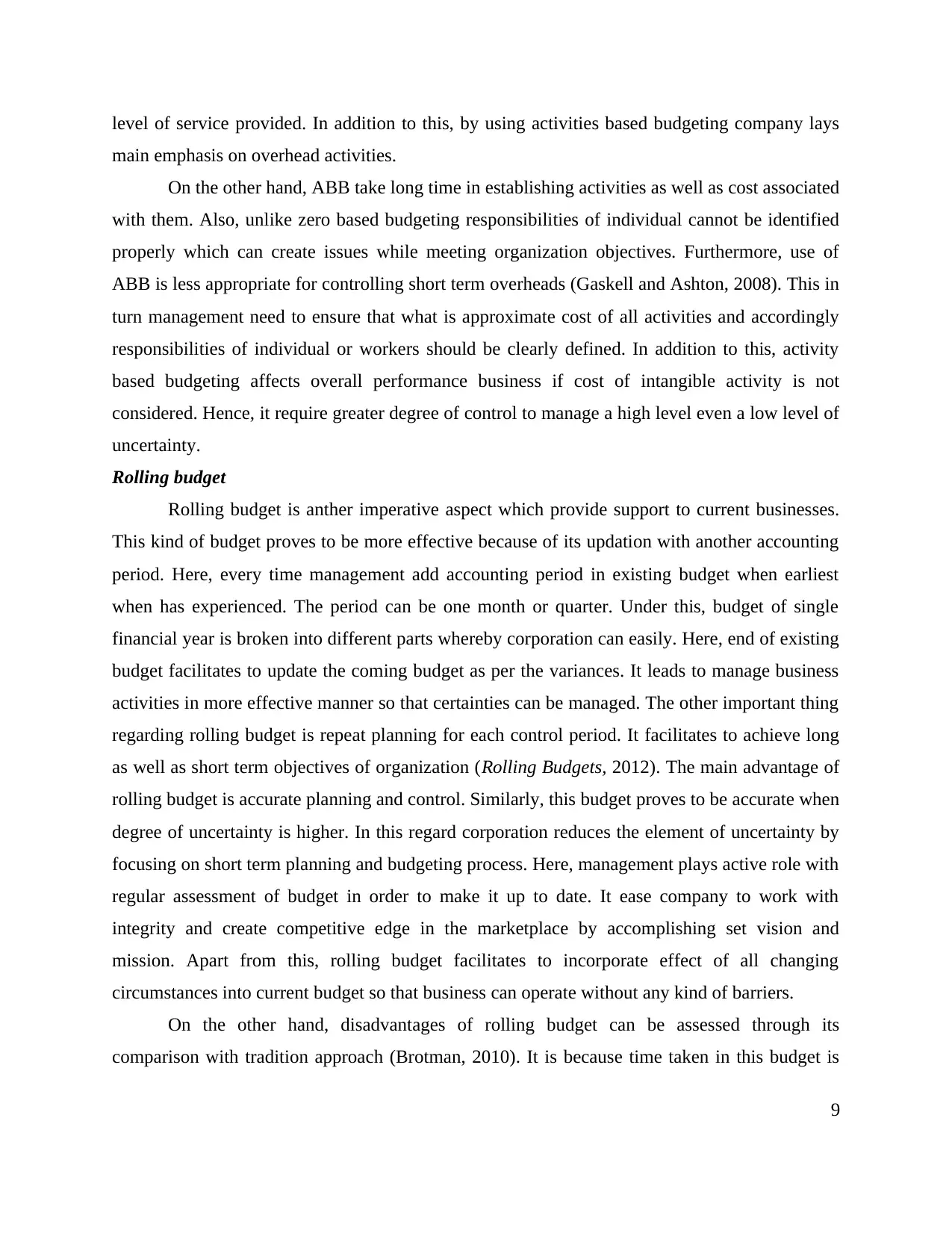
level of service provided. In addition to this, by using activities based budgeting company lays
main emphasis on overhead activities.
On the other hand, ABB take long time in establishing activities as well as cost associated
with them. Also, unlike zero based budgeting responsibilities of individual cannot be identified
properly which can create issues while meeting organization objectives. Furthermore, use of
ABB is less appropriate for controlling short term overheads (Gaskell and Ashton, 2008). This in
turn management need to ensure that what is approximate cost of all activities and accordingly
responsibilities of individual or workers should be clearly defined. In addition to this, activity
based budgeting affects overall performance business if cost of intangible activity is not
considered. Hence, it require greater degree of control to manage a high level even a low level of
uncertainty.
Rolling budget
Rolling budget is anther imperative aspect which provide support to current businesses.
This kind of budget proves to be more effective because of its updation with another accounting
period. Here, every time management add accounting period in existing budget when earliest
when has experienced. The period can be one month or quarter. Under this, budget of single
financial year is broken into different parts whereby corporation can easily. Here, end of existing
budget facilitates to update the coming budget as per the variances. It leads to manage business
activities in more effective manner so that certainties can be managed. The other important thing
regarding rolling budget is repeat planning for each control period. It facilitates to achieve long
as well as short term objectives of organization (Rolling Budgets, 2012). The main advantage of
rolling budget is accurate planning and control. Similarly, this budget proves to be accurate when
degree of uncertainty is higher. In this regard corporation reduces the element of uncertainty by
focusing on short term planning and budgeting process. Here, management plays active role with
regular assessment of budget in order to make it up to date. It ease company to work with
integrity and create competitive edge in the marketplace by accomplishing set vision and
mission. Apart from this, rolling budget facilitates to incorporate effect of all changing
circumstances into current budget so that business can operate without any kind of barriers.
On the other hand, disadvantages of rolling budget can be assessed through its
comparison with tradition approach (Brotman, 2010). It is because time taken in this budget is
9
main emphasis on overhead activities.
On the other hand, ABB take long time in establishing activities as well as cost associated
with them. Also, unlike zero based budgeting responsibilities of individual cannot be identified
properly which can create issues while meeting organization objectives. Furthermore, use of
ABB is less appropriate for controlling short term overheads (Gaskell and Ashton, 2008). This in
turn management need to ensure that what is approximate cost of all activities and accordingly
responsibilities of individual or workers should be clearly defined. In addition to this, activity
based budgeting affects overall performance business if cost of intangible activity is not
considered. Hence, it require greater degree of control to manage a high level even a low level of
uncertainty.
Rolling budget
Rolling budget is anther imperative aspect which provide support to current businesses.
This kind of budget proves to be more effective because of its updation with another accounting
period. Here, every time management add accounting period in existing budget when earliest
when has experienced. The period can be one month or quarter. Under this, budget of single
financial year is broken into different parts whereby corporation can easily. Here, end of existing
budget facilitates to update the coming budget as per the variances. It leads to manage business
activities in more effective manner so that certainties can be managed. The other important thing
regarding rolling budget is repeat planning for each control period. It facilitates to achieve long
as well as short term objectives of organization (Rolling Budgets, 2012). The main advantage of
rolling budget is accurate planning and control. Similarly, this budget proves to be accurate when
degree of uncertainty is higher. In this regard corporation reduces the element of uncertainty by
focusing on short term planning and budgeting process. Here, management plays active role with
regular assessment of budget in order to make it up to date. It ease company to work with
integrity and create competitive edge in the marketplace by accomplishing set vision and
mission. Apart from this, rolling budget facilitates to incorporate effect of all changing
circumstances into current budget so that business can operate without any kind of barriers.
On the other hand, disadvantages of rolling budget can be assessed through its
comparison with tradition approach (Brotman, 2010). It is because time taken in this budget is
9
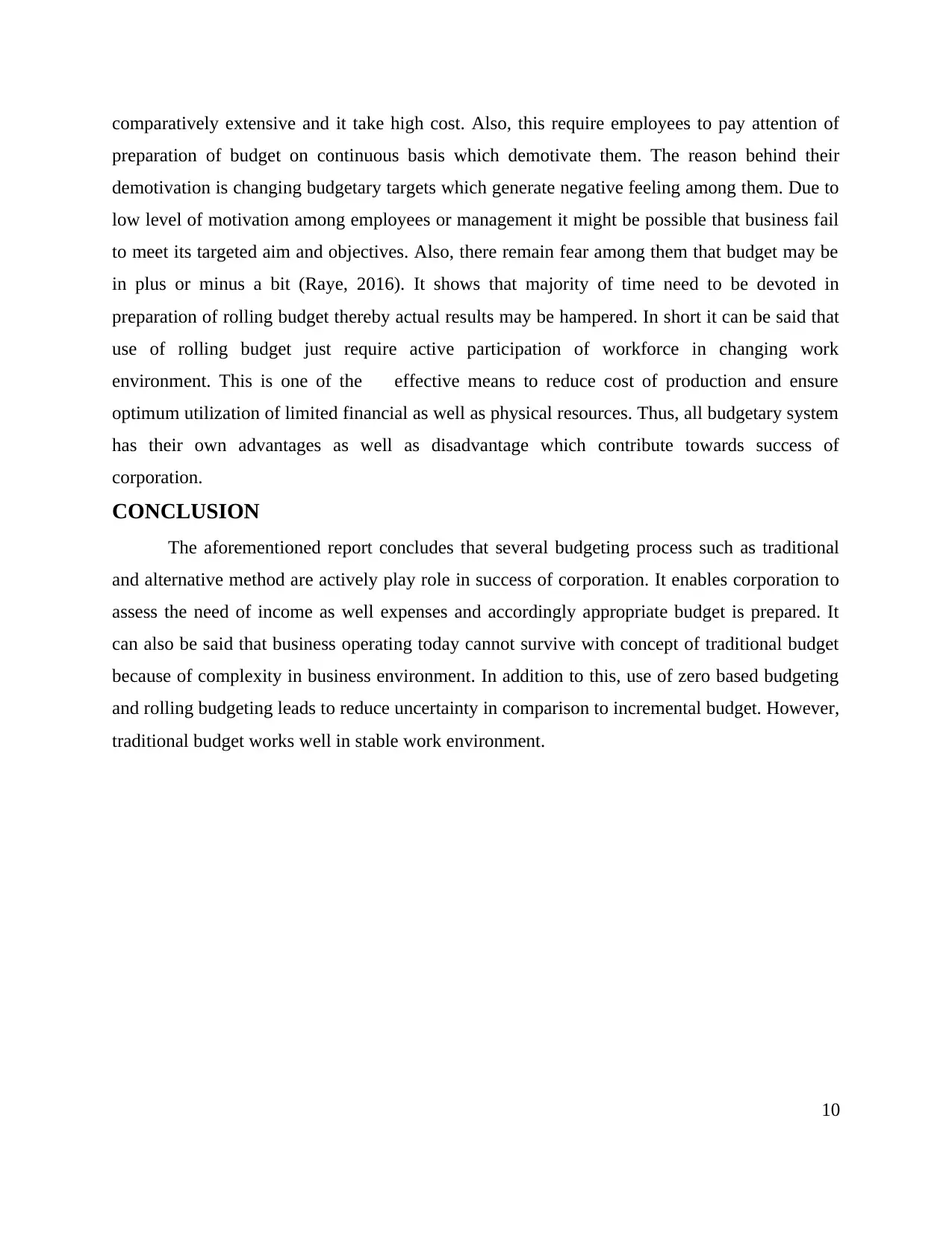
comparatively extensive and it take high cost. Also, this require employees to pay attention of
preparation of budget on continuous basis which demotivate them. The reason behind their
demotivation is changing budgetary targets which generate negative feeling among them. Due to
low level of motivation among employees or management it might be possible that business fail
to meet its targeted aim and objectives. Also, there remain fear among them that budget may be
in plus or minus a bit (Raye, 2016). It shows that majority of time need to be devoted in
preparation of rolling budget thereby actual results may be hampered. In short it can be said that
use of rolling budget just require active participation of workforce in changing work
environment. This is one of the effective means to reduce cost of production and ensure
optimum utilization of limited financial as well as physical resources. Thus, all budgetary system
has their own advantages as well as disadvantage which contribute towards success of
corporation.
CONCLUSION
The aforementioned report concludes that several budgeting process such as traditional
and alternative method are actively play role in success of corporation. It enables corporation to
assess the need of income as well expenses and accordingly appropriate budget is prepared. It
can also be said that business operating today cannot survive with concept of traditional budget
because of complexity in business environment. In addition to this, use of zero based budgeting
and rolling budgeting leads to reduce uncertainty in comparison to incremental budget. However,
traditional budget works well in stable work environment.
10
preparation of budget on continuous basis which demotivate them. The reason behind their
demotivation is changing budgetary targets which generate negative feeling among them. Due to
low level of motivation among employees or management it might be possible that business fail
to meet its targeted aim and objectives. Also, there remain fear among them that budget may be
in plus or minus a bit (Raye, 2016). It shows that majority of time need to be devoted in
preparation of rolling budget thereby actual results may be hampered. In short it can be said that
use of rolling budget just require active participation of workforce in changing work
environment. This is one of the effective means to reduce cost of production and ensure
optimum utilization of limited financial as well as physical resources. Thus, all budgetary system
has their own advantages as well as disadvantage which contribute towards success of
corporation.
CONCLUSION
The aforementioned report concludes that several budgeting process such as traditional
and alternative method are actively play role in success of corporation. It enables corporation to
assess the need of income as well expenses and accordingly appropriate budget is prepared. It
can also be said that business operating today cannot survive with concept of traditional budget
because of complexity in business environment. In addition to this, use of zero based budgeting
and rolling budgeting leads to reduce uncertainty in comparison to incremental budget. However,
traditional budget works well in stable work environment.
10
Secure Best Marks with AI Grader
Need help grading? Try our AI Grader for instant feedback on your assignments.
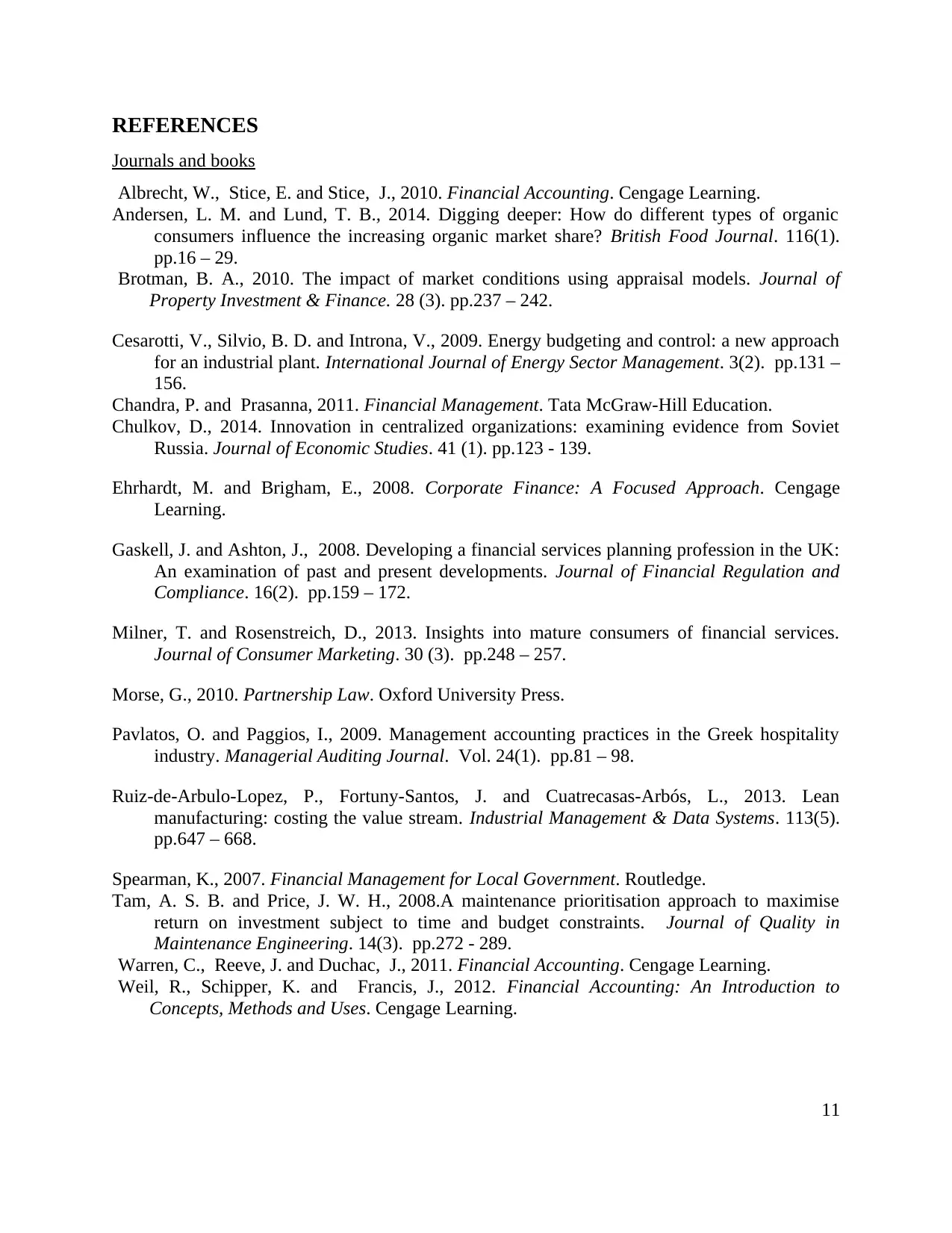
REFERENCES
Journals and books
Albrecht, W., Stice, E. and Stice, J., 2010. Financial Accounting. Cengage Learning.
Andersen, L. M. and Lund, T. B., 2014. Digging deeper: How do different types of organic
consumers influence the increasing organic market share? British Food Journal. 116(1).
pp.16 – 29.
Brotman, B. A., 2010. The impact of market conditions using appraisal models. Journal of
Property Investment & Finance. 28 (3). pp.237 – 242.
Cesarotti, V., Silvio, B. D. and Introna, V., 2009. Energy budgeting and control: a new approach
for an industrial plant. International Journal of Energy Sector Management. 3(2). pp.131 –
156.
Chandra, P. and Prasanna, 2011. Financial Management. Tata McGraw-Hill Education.
Chulkov, D., 2014. Innovation in centralized organizations: examining evidence from Soviet
Russia. Journal of Economic Studies. 41 (1). pp.123 - 139.
Ehrhardt, M. and Brigham, E., 2008. Corporate Finance: A Focused Approach. Cengage
Learning.
Gaskell, J. and Ashton, J., 2008. Developing a financial services planning profession in the UK:
An examination of past and present developments. Journal of Financial Regulation and
Compliance. 16(2). pp.159 – 172.
Milner, T. and Rosenstreich, D., 2013. Insights into mature consumers of financial services.
Journal of Consumer Marketing. 30 (3). pp.248 – 257.
Morse, G., 2010. Partnership Law. Oxford University Press.
Pavlatos, O. and Paggios, I., 2009. Management accounting practices in the Greek hospitality
industry. Managerial Auditing Journal. Vol. 24(1). pp.81 – 98.
Ruiz-de-Arbulo-Lopez, P., Fortuny-Santos, J. and Cuatrecasas-Arbós, L., 2013. Lean
manufacturing: costing the value stream. Industrial Management & Data Systems. 113(5).
pp.647 – 668.
Spearman, K., 2007. Financial Management for Local Government. Routledge.
Tam, A. S. B. and Price, J. W. H., 2008.A maintenance prioritisation approach to maximise
return on investment subject to time and budget constraints. Journal of Quality in
Maintenance Engineering. 14(3). pp.272 - 289.
Warren, C., Reeve, J. and Duchac, J., 2011. Financial Accounting. Cengage Learning.
Weil, R., Schipper, K. and Francis, J., 2012. Financial Accounting: An Introduction to
Concepts, Methods and Uses. Cengage Learning.
11
Journals and books
Albrecht, W., Stice, E. and Stice, J., 2010. Financial Accounting. Cengage Learning.
Andersen, L. M. and Lund, T. B., 2014. Digging deeper: How do different types of organic
consumers influence the increasing organic market share? British Food Journal. 116(1).
pp.16 – 29.
Brotman, B. A., 2010. The impact of market conditions using appraisal models. Journal of
Property Investment & Finance. 28 (3). pp.237 – 242.
Cesarotti, V., Silvio, B. D. and Introna, V., 2009. Energy budgeting and control: a new approach
for an industrial plant. International Journal of Energy Sector Management. 3(2). pp.131 –
156.
Chandra, P. and Prasanna, 2011. Financial Management. Tata McGraw-Hill Education.
Chulkov, D., 2014. Innovation in centralized organizations: examining evidence from Soviet
Russia. Journal of Economic Studies. 41 (1). pp.123 - 139.
Ehrhardt, M. and Brigham, E., 2008. Corporate Finance: A Focused Approach. Cengage
Learning.
Gaskell, J. and Ashton, J., 2008. Developing a financial services planning profession in the UK:
An examination of past and present developments. Journal of Financial Regulation and
Compliance. 16(2). pp.159 – 172.
Milner, T. and Rosenstreich, D., 2013. Insights into mature consumers of financial services.
Journal of Consumer Marketing. 30 (3). pp.248 – 257.
Morse, G., 2010. Partnership Law. Oxford University Press.
Pavlatos, O. and Paggios, I., 2009. Management accounting practices in the Greek hospitality
industry. Managerial Auditing Journal. Vol. 24(1). pp.81 – 98.
Ruiz-de-Arbulo-Lopez, P., Fortuny-Santos, J. and Cuatrecasas-Arbós, L., 2013. Lean
manufacturing: costing the value stream. Industrial Management & Data Systems. 113(5).
pp.647 – 668.
Spearman, K., 2007. Financial Management for Local Government. Routledge.
Tam, A. S. B. and Price, J. W. H., 2008.A maintenance prioritisation approach to maximise
return on investment subject to time and budget constraints. Journal of Quality in
Maintenance Engineering. 14(3). pp.272 - 289.
Warren, C., Reeve, J. and Duchac, J., 2011. Financial Accounting. Cengage Learning.
Weil, R., Schipper, K. and Francis, J., 2012. Financial Accounting: An Introduction to
Concepts, Methods and Uses. Cengage Learning.
11
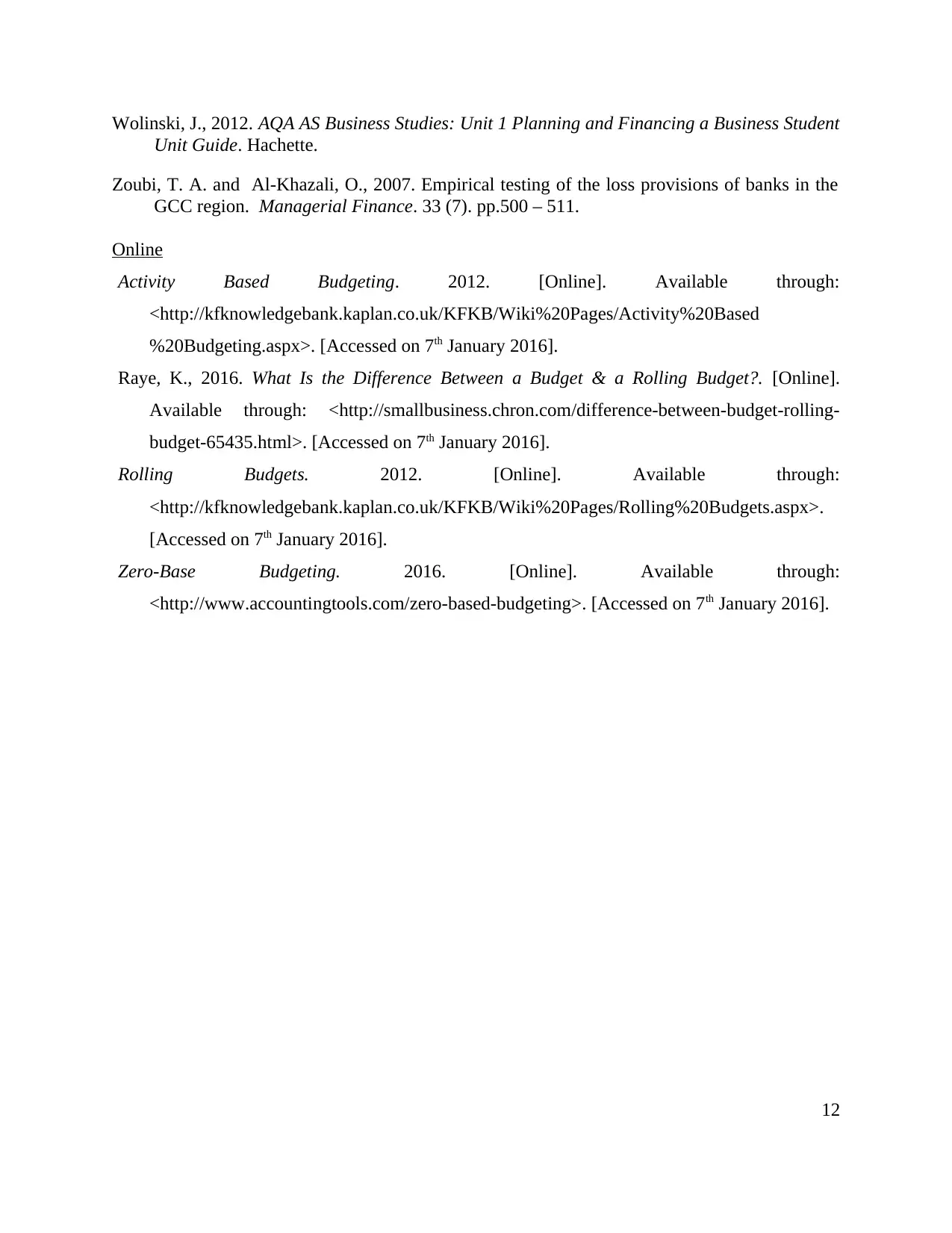
Wolinski, J., 2012. AQA AS Business Studies: Unit 1 Planning and Financing a Business Student
Unit Guide. Hachette.
Zoubi, T. A. and Al-Khazali, O., 2007. Empirical testing of the loss provisions of banks in the
GCC region. Managerial Finance. 33 (7). pp.500 – 511.
Online
Activity Based Budgeting. 2012. [Online]. Available through:
<http://kfknowledgebank.kaplan.co.uk/KFKB/Wiki%20Pages/Activity%20Based
%20Budgeting.aspx>. [Accessed on 7th January 2016].
Raye, K., 2016. What Is the Difference Between a Budget & a Rolling Budget?. [Online].
Available through: <http://smallbusiness.chron.com/difference-between-budget-rolling-
budget-65435.html>. [Accessed on 7th January 2016].
Rolling Budgets. 2012. [Online]. Available through:
<http://kfknowledgebank.kaplan.co.uk/KFKB/Wiki%20Pages/Rolling%20Budgets.aspx>.
[Accessed on 7th January 2016].
Zero-Base Budgeting. 2016. [Online]. Available through:
<http://www.accountingtools.com/zero-based-budgeting>. [Accessed on 7th January 2016].
12
Unit Guide. Hachette.
Zoubi, T. A. and Al-Khazali, O., 2007. Empirical testing of the loss provisions of banks in the
GCC region. Managerial Finance. 33 (7). pp.500 – 511.
Online
Activity Based Budgeting. 2012. [Online]. Available through:
<http://kfknowledgebank.kaplan.co.uk/KFKB/Wiki%20Pages/Activity%20Based
%20Budgeting.aspx>. [Accessed on 7th January 2016].
Raye, K., 2016. What Is the Difference Between a Budget & a Rolling Budget?. [Online].
Available through: <http://smallbusiness.chron.com/difference-between-budget-rolling-
budget-65435.html>. [Accessed on 7th January 2016].
Rolling Budgets. 2012. [Online]. Available through:
<http://kfknowledgebank.kaplan.co.uk/KFKB/Wiki%20Pages/Rolling%20Budgets.aspx>.
[Accessed on 7th January 2016].
Zero-Base Budgeting. 2016. [Online]. Available through:
<http://www.accountingtools.com/zero-based-budgeting>. [Accessed on 7th January 2016].
12
1 out of 12
Related Documents
Your All-in-One AI-Powered Toolkit for Academic Success.
+13062052269
info@desklib.com
Available 24*7 on WhatsApp / Email
![[object Object]](/_next/static/media/star-bottom.7253800d.svg)
Unlock your academic potential
© 2024 | Zucol Services PVT LTD | All rights reserved.





